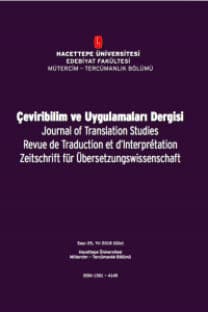Patent Metinlerinin Çevirisi: Tarifname ve İstemlerin Dilsel Özellikleri
Translation of Patent Documents: Language of Descriptions and Claims
patent translation, technical translation, claims, specifications, description,
___
- Ascheron, C. and Kickuth, A. (2005). Make your mark in science: Creativity, presenting, publishing, and patents: A guide for young scientists. Hoboken, NJ: Wiley.
- Byrne, J. (2006). Technical translation: Usability strategies for translating technical documentation. Dordrecht, Netherlands: Springer.
- Byrne, J. (2007). Caveat translator: Understanding the legal consequences of Errors in Professional Translation. Journal of Specialised Translation 2007, 7, 2-24.
- Carr, F. K. (2009). Patents Handbook. North Carolina: McFarland.
- Daldeniz, E. (2004). Kültürlerarası aktarımda dil ve çeviri olgusuna bakış – Bir metin alt türü olarak patent metinlerinin türkçede oluşum serüveni. (Unpublished PhD Dissertation) İstanbul Üniversitesi, İstanbul.
- Erten, A. (1997). Approaches to technical translation. Çeviribilim ve Uygulamaları Dergisi, 7, 17-22.
- Estrin, H. A. (1963). Technical and professional writing: A practical anthology. New York: Harcourt, Brace and World.
- European Patent Office (May 2010). How to get a European patent: Guide for applicants. 13th ed. Retrieved from http://documents.epo.org/projects/babylon/eponet.nsf/0/8266ED0366190630C12575E10051F40E/$File/guide_for_applicants_part1_05_10_en.pdf
- European Patent Convention [EPC] (1973). 14th Edition, August 2010. European Patent Office. Retrieved from: http://documents.epo.org/projects/babylon/eponet.nsf/0/7bacb229e032863dc12577ec004ada98/$FILE/EPC_14th_edition.pdf
- Finch, C. (1969). An approach to technical translation: An introductory guide for scientific readers. Oxford and New York: Pergamon Press.
- Harhoff, D.; Hoisl, K.; Reichl, B. and van Pottelsberghe de la Potterie, B. (2007). Patent validation at the country level - role of fees and translation costs. CEPR Discussion Paper No 6565.
- Hirschhorn, H. H. (1980). Writing for science, industry, and technology. New York: D. Van Nostrand.
- Hitchcock, D. (2009). Patent searching made easy (5th Edition). California: Nolo.
- Lefevere, A. (1992). Translation, history, culture: A sourcebook. London and New York: Routledge.
- Loring, D. (2005). The patent litigation. Chicago: American Bar Association.
- Lyon, M. (2005). Japanese patents: Practical course in technical translation. Rockville, USA: Schreiber Publishing.
- Maksimova, E. A. (2009). Russian translation: Theory and practice. Hoboken, NJ: Taylor and Francis.
- Mimick, R.; Smith, W. E. and Thompson, M. (2005). Business diagnostics. Canada: Trafford Publishing.
- Mohan, C. (2011, May 12). How to write an effective description for your patent application. Retrieved from: http://ezinearticles.com/?how-to-write-an-effective-description-for-your-patent-application&id=6262562
- Munday, J. (2001). Introducing translation studies – Theories and applications. London and New York: Routledge.
- Pasa, B. and Benacchio, A. (2005). The harmonization of civil and commercial law. Hungary: Akaprint Nyomda.
- Patent Cooperation Treaty [PCT] (1970) As in force from April 1, 2002. World Intellectual Property Organization. Retrieved from http://www.wipo.int/pct/en/texts/articles/atoc.htm
- Pienkos, J. T. (2004). The patent guidebook. Chicago: American Bar Association.
- Sheremetyeva, S. (2003). Natural language analysis of patent claims. In Patent '03 Proceedings of The Acl-2003 Workshop On Patent Corpus Processing (pp. 66-73). Stroudsburg, PA, USA: Association for Computational Linguistics.
- Sheremetyeva, S. and Nirenburg, S. (1996). Generating patent claims. In Proceedings of The 8th International Workshop on Natural Language Generation. Herstmonceux, Sussex, UK.
- Shinmori, A., Okumura, M., Marukawa, Y. and Iwayama, M. (2003). Patent Claim Processing For Readability: Structure Analysis and Term Explanation. ACL-03 Workshop on Patent Corpus Processing, pp. 56-65.
- Taner, G. (2011) A descriptive study on the Turkish translations of European patent documents. (Unpublished MA Thesis) Hacettepe University, Institute of Social Sciences, Ankara.
- Tankha, A., Bout, L., Fernandes, S. and K.S., S. (2011). Patent your idea. Bloomington: Authorhouse.
- Türk Patent Enstitüsü (January, 2010). Patent-faydalı model başvuru kılavuzu. Ankara: TPE.
- Venuti, L. (Ed.) (2000) The translation studies reader. London and New York: Routledge.
- Zerling, K. (2010, January). Translating a patent: translators' templates. Retrieved from Translation Journal, Vol.14 No.1: http://translationjournal.net/journal/51patents.htm
- 551 Sayılı Patent Haklarının Korunması Hakkında Kanun Hükmünde Kararname. (1995). TC. Resmi Gazete, 22326, 27 Haziran 1995.
- 551 Sayılı Patent Haklarının Korunması Hakkında Kanun Hükmünde Kararnamenin Uygulama Şeklini Gösterir Yönetmelik. (1995). TC. Resmi Gazete, 22454, 5 Kasım 1995.
- Legal Documents
- European Patent Convention, 14th Edition, 2010 and Implementing Regulations to the EPC, 2010 available on the official website of EPO: http://www.epo.org/law-practice/legal-texts/epc.html
- Convention Establishing The World intellectual Property Organization (1967) As Amended On September 28, 1979. WIPO, 14 July 1967.
- Patent Cooperation Treaty available on the official website of WIPO: http://www.wipo.int/pct/en/texts/articles/atoc.htm
- Regulations Under the Patent Cooperation Treaty available on the official website of WIPO: http://www.wipo.int/pct/en/texts/rules/
- Decree Law 551 Pertaining to the Protection of Patent Rights, 1995 available on the official website of TPI: http://www.tpe.gov.tr/dosyalar/EN_khk/Patent_DecreeLaw.pdf
- The Implementing Regulations Under The Decree-Law No 551 Pertaining To The Protection of Patent Rights. available on the official website of TPI: http://www.tpe.gov.tr/dosyalar/EN_khk/Patent_Regulation.pdf
- Yayın Aralığı: Yılda 2 Sayı
- Başlangıç: 1991
- Yayıncı: Hacettepe Üniversitesi
Neil Gaiman'ın Yıldız Tozu [Stardust] Romanının Sinema Uyarlaması Üzerine Bir Eleştiri Yazısı
Özel Alan Çevirisi: Akademik Eğitim Uygulamalarında Teknoloji ve Sosyal Medya
Görme Engelliler için Erişilebilir bir Etkinlik Alanı olarak Engelsiz Filmler Festivali
Türkiye’de Hastane Çevirmenliğinde Rol ve Etik
Burcu TAŞKIN, Emine BOGENÇ DEMİREL
Habitus ve Çevirmenler: Orhan Pamuk’un Benim Adım Kırmızı Romanı
Karikatürlerde Çevirmen ve Çeviri
Ayşe Şirin OKYAYUZ, Mümtaz KAYA
